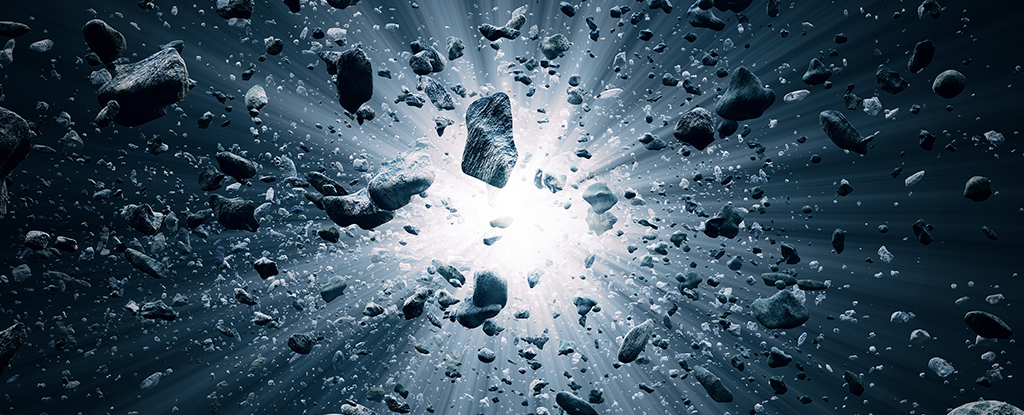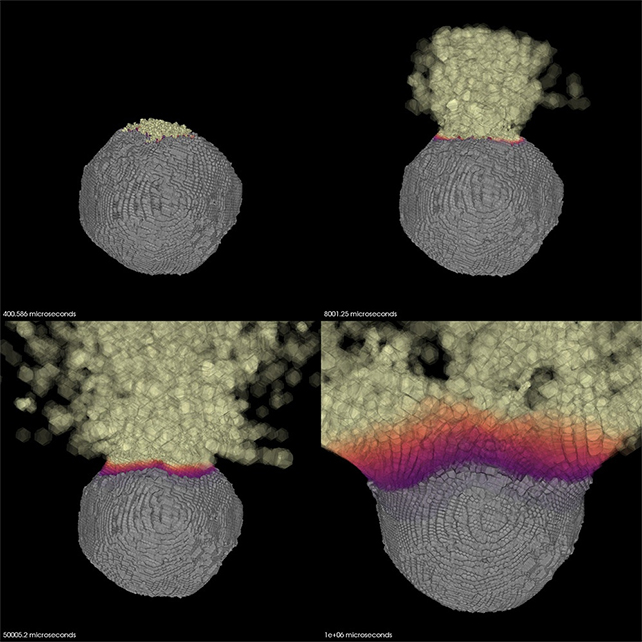
While a popular theme in disaster movies, detonating a nuclear device on an approaching asteroid has been deemed a highly unfavorable strategy in the real world.
While a nuclear bomb might effectively obliterate a smaller asteroid, using it on a larger one would likely result in fragmentation. These fragments could still pose a threat to Earth, potentially exacerbating the situation by triggering multiple impacts across the planet.
However, is employing nuclear weapons against an approaching asteroid truly an ill-advised strategy? With the right approach, a nuclear blast might serve as a potential means to deflect an asteroid.
Scientists at Lawrence Livermore National Laboratory (LLNL) have developed a modeling tool capable of simulating the potential outcomes of detonating a nuclear device above an asteroid’s surface. This tool enhances our understanding of how radiation from a nuclear blast interacts with the asteroid’s surface and examines the shockwave dynamics that could impact the asteroid’s interior.
The explosive method known as nuclear ablation involves utilizing the blast’s radiation to vaporize a portion of the asteroid’s surface, creating an explosive thrust and inducing a change in velocity.

The model can include various initial conditions, mimicking the types of asteroids that have been recently observed up close, ranging from solid rocks to rubble piles. These simulations are providing planetary scientists with additional insights and a broader range of options for scenarios where a space rock could potentially pose a threat to Earth.
“If we have enough warning time, we could potentially launch a nuclear device, sending it millions of miles away to an asteroid that is headed toward Earth,” said researcher Mary Burkey from LLNL.
“We would then detonate the device and either deflect the asteroid, keeping it intact but providing a controlled push away from Earth, or we could disrupt the asteroid, breaking it up into small, fast-moving fragments that would also miss the planet.”
Thanks to the Double Asteroid Redirection Test (DART) mission, where a kinetic impactor intentionally collided with an asteroid to alter its trajectory, scientists have acquired valuable insights into redirecting hazardous asteroids. The newly developed model, known as the X-ray energy deposition model, equips researchers with the tools to build upon the lessons from DART while exploring the potential of nuclear ablation as an alternative to kinetic impact missions.
Burkey mentioned in an LLNL press release that nuclear devices possess the highest energy density per unit of mass among human technologies, making them a potentially invaluable tool in addressing asteroid threats.
However, as outlined in their paper published in The Planetary Science Journal, “predicting the effectiveness of a potential nuclear deflection or disruption mission depends on accurate multiphysics simulations of the device’s X-ray energy deposition into the asteroid and the resulting material ablation.”
The team aimed to develop an efficient and accurate method for modeling nuclear deflection, considering the various complex physics packages required for simulations. These simulations cover a broad range of physical properties of an asteroid, spanning many orders of magnitude and demanding significant computational resources. Burkey and her colleagues worked towards achieving this goal.
Burkey mentioned that their advanced simulations can accurately trace photons penetrating surfaces composed of materials resembling asteroids, including rock, iron, and ice. These simulations also consider intricate processes like reradiation.
The model also takes into account a diverse range of asteroid compositions. This inclusive approach enhances the model’s applicability to a broad spectrum of potential asteroid scenarios.
In the event of an actual planetary defense emergency, Megan Bruck Syal, LLNL’s planetary defense project lead, emphasized that this high-fidelity simulation modeling will be crucial in offering decision-makers actionable, risk-informed information. This information could be instrumental in preventing asteroid impacts, safeguarding vital infrastructure, and ultimately saving lives.
“While the probability of a large asteroid impact during our lifetime is low, the potential consequences could be devastating,” Bruck Syal said.
This content was initially featured on Universe Today.





